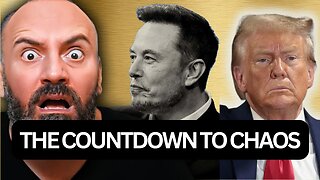Premium Only Content

How Does Exercise Impact Weight Loss fast?
Here is a Free E-book That Will Help You In Your Weight Loss Journey.
Click Here To Get your Own Copy. https://bit.ly/3rDzu01
Animation description: In this animation, we discuss the concept of physical activity and exercise as they relate to obesity.
In humans there is a fine balance between energy intake and energy expenditure.
Energy intake is in the form of food, and energy expenditure is in the form of the basal metabolic rate and physical activity.
The difference between energy intake and energy expenditure is the net energy balance. If intake exceeds expenditure, then a net positive energy balance occurs.
Energy expenditure depends on a number of factors.
This includes the starting body weight, the basal metabolic rate and physical activity.
With regards to physical activity, there are several key variables including the frequency, intensity, duration and type of activity done.
Here is a Free E-book That Will Help You In Your Weight Loss Journey.
Click Here To Get your Own Copy. https://bit.ly/3rDzu01
Let us now examine energy consumption. One honey glazed donut is shown which has approximately 300 kilocalories.
The energy intake from the consumed donut is equal to the energy consumed by moderate walking for 30-60 minutes, at 3.0 miles per hour.
If an individual walks for an hour at 3 miles per hour.
They will expend approximately 300 kilocalories, the same as what was contained in the consumed donut.
If an individual walks daily for one hour at approximately 3 miles per hour. This type of activity would lead to weight loss. This assumes that the individual does not consume any extra calories and has a net negative energy expenditure.
If this activity continues for a period of two to four months, body weight is reduced as depicted.
The initial weight loss is the result of a negative net energy balance.
The negative energy balance is because energy expenditure exceeds energy intake.
After the initial weight loss, the individual continues to do the same type of exercise, that is, 1 hour of moderate walking daily.
The chart depicts changes in body weight over time.
Individuals are surprised and frustrated that his weight is not continuing to decrease despite regular walking.
They have reached a plateau.
The reason behind the weight loss pleateau is that with decreased body weight, the basal metabolic rate also decreases.
When the basal metabolic rate decreases, there is a decrease in total energy expenditure.
If the discouraged individual quits his daily walking exercise. The weight is gained again, at a quicker pace.
The weight is re-gained as a result of a positive energy balance being created.
Energy expenditure is now less since the physical activity has been stopped.
By keeping the same intensity and duration of walking without making any changes in the diet (energy intake) the man would enter a weight maintenance phase.
This is characterised by gaining a small amount of weight.
The weight maintenance is the result of an energy balance being established within the body, where energy intake essentially equals energy expenditure.
If there is no change in energy balance, there will not be any further change in weight.
What must be done to end the weight loss plateau?
Several options exist to maintain a negative net energy balance. These involve either decreasing energy intake or increasing energy expenditure.
Options include: restricting calories further or increasing the frequency, or the intensity or the duration of the exercise.
In summary then, weight loss plateau's are expected and can only end with continued exercise and a net negative energy balance.
Stopping exercise or increasing calories will lead to weight gain.
If one continues to exercise to maintain a net negative energy balance weight loss will be promoted.
Here is a Free E-book That Will Help You In Your Weight Loss Journey.
Click Here To Get your Own Copy. https://bit.ly/3rDzu01
-
 4:21
4:21
dacardi
3 years agoHow to Lose Weight Fast Without Exercise l How To Lose Weight Fast without Workout.
187 -
 6:11
6:11
KTNV
3 years agoWeight Loss Success
24 -
 58:10
58:10
Kimberly Guilfoyle
22 hours agoAmerica is Back & The Future is Bright: A Year in Review | Ep. 183
153K65 -
 3:03:27
3:03:27
vivafrei
1 day agoEp. 242: Barnes is BACK AGAIN! Trump, Fani, J6, RFK, Chip Roy, USS Liberty AND MORE! Viva & Barnes
233K231 -
 2:05:48
2:05:48
2 MIKES LIVE
3 hours agoTHE MIKE SCHWARTZ SHOW with DR. MICHAEL J SCHWARTZ 12-24-2024
15.2K1 -
 1:14:17
1:14:17
MTNTOUGH Fitness Lab
1 day agoNavy SEAL Dom Raso: The Cold, Hard Truth About Modern Brotherhood | MTNPOD #96
11.9K1 -
 43:42
43:42
Dad Dojo Podcast
19 hours agoEP14: Every Girl Dad's Biggest Fear and How To Prevent It
7.9K -
 55:06
55:06
Bek Lover Podcast
12 hours agoWill Trump Pull Off A Miracle? Other Strange News Podcast...
6.67K4 -
 55:53
55:53
PMG
1 day ago $0.01 earned"Hannah Faulkner and Courtney Reed | BEHIND THE LENS OF A TRUMP PHOTOGRAPHER"
5.59K -
 8:09:50
8:09:50
Dr Disrespect
1 day ago🔴LIVE - DR DISRESPECT - MARVEL RIVALS - GOLD VANGUARD
225K37